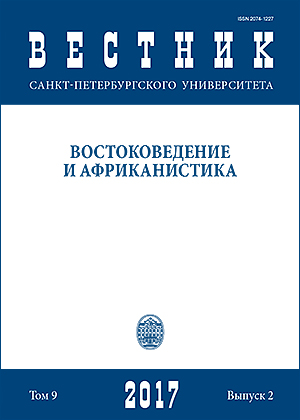On the question of principles for reading of uncommon signs in some runic inscriptions found in Central Asia (Based on Materials of the Ritual Complex Biyreg in the Mongolian Altai)
DOI:
https://doi.org/10.21638/11701/spbu13.2017.206Abstract
The article is devoted to an attempt at interpreting two rare signs of runiform inscriptions of the Asian area based on a reading of a clearly recorded inscription discovered during field work in the Biyreg ritual complex of the Mongolian Altai. The analysis of the excavated archeological objects allows us to relate the inscription to the tribal group Türk (Chin. Tū-jué 突厥) and does it possible to date it, with enough certainty, by the period of the late 7 th — first half of the 8 th centuries, i.e. the period of the socalled Second Türkic Qaghanate. i.e. the period of the so-called Second Türkic Qaghanate. According
to authors, the reading of the inscription can be based on the graphical fund of the Old Türkic runic inscriptions.
Preliminary interpretation of signs, atypical for Old Türkic writing monuments of Asian Areal, permits us to suggest the following reading of the inscription.
Transliteration: k2l2r1ŚƏn1 ČM(IM?)Əš1w1
Transcription: k(e)l (a)rśi-ə (a)n(a)č(ï)m-ə šu!
Translate: ‘Oh, let’s come, ah, noble (or saint), ah, our dear mother!’.
Considering this hypothetical reading, the authors do not rush to offer any interpretation of the contents of the inscription.
Keywords:
Old Türkic runic inscriptions, paleography, ritual complex, enclosure, dating
Downloads
References
References
Downloads
Published
How to Cite
Issue
Section
License
Articles of "Vestnik of Saint Petersburg University. Asian and African Studies" are open access distributed under the terms of the License Agreement with Saint Petersburg State University, which permits to the authors unrestricted distribution and self-archiving free of charge.





